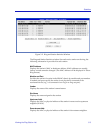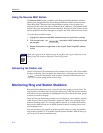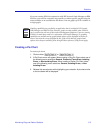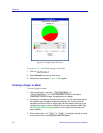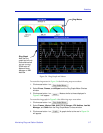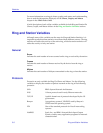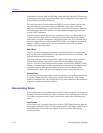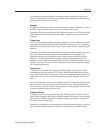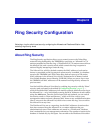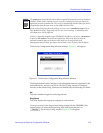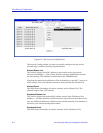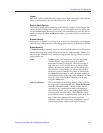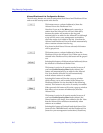
Ring and Station Variables 5-11
Statistics
Lost frames are usually caused by a station entering or leaving the ring as the
frame is circulating. Lost frames will cause the active monitor to initiate the ring
purge process and issue a new token.
Congest
A congestion error occurs when a station recognizes a frame addressed to it, but is
unable to copy the frame because it has no available buffer space.
Although this indicates a station which is performing poorly, it will not adversely
affect other stations on the network; therefore, no ring recovery procedures are
initiated.
Frame Copy
An FC error is counted each time a station recognizes a frame addressed to itself
and detects that the Frame Status field’s ARI bits are already set to 1, indicating
that there has possibly been a line surge, or that another station is duplicating its
address.
Note that it is virtually impossible to have a ring with duplicate addresses, since
most of the time the ring uses the hard-coded address on the adapter, and
duplicate addresses are checked for when a station inserts itself into the ring.
However, a system administrator can pass a locally assigned address to the
adapter, so it is possible to unintentionally administer a duplicate address while a
device is on a ring. This error is more commonly caused by transparent bridging
on a Token Ring network.
Token Errors
A token error is counted when the active monitor either does not see a token
circulating on the ring before its TVX (Timer, Valid Transmission) timer expires
(e.g., a lost Frame error has occurred), or sees a recirculating frame or token. Each
time a token error is noted, the active monitor purges the ring and issues a new
token.
As in lost frames, the major cause for token errors is the disruption of the ring as
stations enter or leave the ring. Note that token errors are only reported by an
active monitor. If you see a token error reported by another station, it was serving
as active monitor at some previous time.
Frequency Errors
A frequency error occurs when the ring clock frequency and a station’s internal
crystal clock frequency differ by an excessive amount. This type of error happens
more often on 16 Mbps rings than on 4 Mbps rings; it can also be a symptom of
too many stations on the ring.
Detection of a frequency error initiates the monitor contention process, since this
typically indicates that the active monitor is not present or is malfunctioning.



